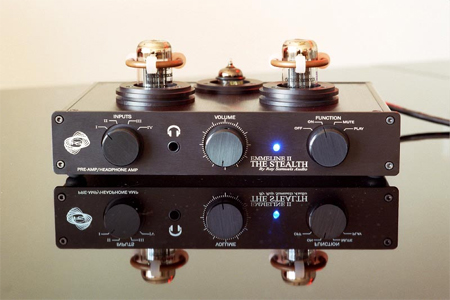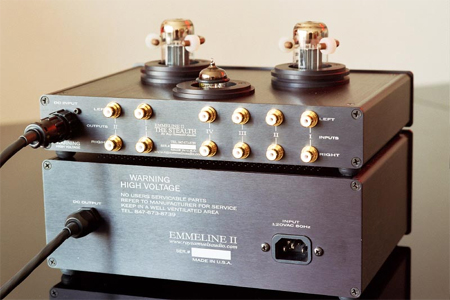You are reading the older HTML site
Positive Feedback ISSUE
16
november/december 2004
ray samuels audio
Stealth preamplifier
as reviewed by Ed Morawski

|
ED MORAWSKI'S SYSTEM: LOUDSPEAKERS ELECTRONICS SOURCE CABLES ACCESSORIES
|
The Stealth preamp from Ray Samuels Audio appears to be their new top-of-the-line product. Ray Samuels apparently went all out on this design. The Stealth arrives in a compact package only ten inches wide, which more closely matches the separate power supply than his previous products. The fit and finish of this made-in-the-U.S. product exudes quality, though its form is strictly functional. It is a simple yet elegant design. The beefy power supply can be placed alongside or under the Stealth. I tried it at the limit of its five-foot umbilical cord as well as next to and under the Stealth, and could discern no difference in sound quality.
According to Ray Samuels' website, the Stealth is manufactured with the highest quality audiophile-grade components and the shortest possible signal paths. The capacitors are polypropylene units by Hovland (Musicap). The film resistors are Halco H2s. For volume control, the Stealth utilizes the DACT stereo attenuator for its transparency and accurate tracking. All components are hand selected and matched between left and right channels, and soldered with their values facing up and toward the same side. The tube sockets are ceramic, with gold contacts for the best conductivity.
The Stealth is built on a solid dual-sided PC board made of military-grade FR4 material and oxygen-free copper. The components are soldered with milspec solders, and cleaned from all residue and contamination to a perfect shine. The Stealth design has no wires, as they tend to color the signal. The signal paths are separated from the power paths by runs of solid copper. The Stealth's inputs and outputs are designed around a rotary switch on a special I-O PC board, thereby completely eliminating the use of wires and keeping the signal paths short. A major advantage of this design is that you will find no wires routed from all over the circuit board to the rotary switch, eliminating any chance of crosstalk between the channels. The Stealth has four inputs plus a headphone jack and two sets of outputs, so it is quite versatile. The tube complement consists of two 6SN7s and one 12AX7. All tubes are sourced from Electro Harmonix. Samuels thoughtfully sent along a selection of NOS 12AX7 tubes, but I installed the stock Electro Harmonix for the initial evaluation.
I powered up the Stealth for a few hours before listening. The power switch has four positions: OFF, ON, MUTE, and PLAY. According to the Emmeline website, the switch takes you through the sequence of turning on the filament (heater), then sending a signal to the power supply to turn on the DC voltage. During these operations, the audio signal is completely muted, until the last, when the audio signal is passed through the tubes. I assumed that this meant the tube heaters were on when the unit was OFF, but I wanted to warm up everything, so I turned the switch to ON, at which point a slight problem arose. My balanced power transformer began to hum loudly and vibrate noticeably. I immediately unplugged the Emmeline power supply and tried it straight into the wall. It seemed to be fine. Since my balanced power unit can easily handle over 15 amps, I can't explain this. Perhaps it was not happy with the Emmeline's grounding scheme. The review was done with the power supply plugged directly into the wall.
I was delayed in listening until the following afternoon, so the Stealth had a nice 24-hour warmup.
I spun Best of Sade in my Musical Fidelity NuVista and was greeted with a neutral and polite presentation of "Your Love is King." The Stealth remained polite during the entire CD. It simply got out of the way and letting the music come through as recorded. The Stealth was very quiet, its soundstage stretched across the width of my room, and its imaging was realistic.
As the days went by, I found the Stealth a bit dry, especially for a tube preamp. I'm certain many of you will find the Stealth very much to your liking because of its neutrality, but I yearned for a bit more sparkle, so I decided to try the tubes Ray had sent along. For these tests, I use the second track of Best of Sade, "Hang on to Your Love." This track, which I thought was exceptionally dry through the Stealth, contains several instruments that can sound indistinct on some equipment. At first I changed only the 12AX7 tube. The procedure was quite a challenge. I had to allow for warm-up, so the sequence of events lasted five days, and required that I take copious notes during each session. I had to account for each difference in words because it wasn't possible to rapidly switch tubes, but I attempted to get a good sense of each tube's sound.

First up was an Amperex Bugle Boy, a tube I had never really liked in any piece of gear. I didn't like it in the Stealth either. It was too raspy, and even drier than the Electro Harmonix. Next I tried a Black Plate 12AU7, which sounded a lot richer but had a tizzy quality on certain instruments. I knew this one would eventually drive me crazy. A NOS RCA 12AX7 was next, and it was a vast improvement over all the previous tubes. It sounded clean and clear, and was fairly musical. All the instruments snapped into focus and took on lives of their own. The final contender was a Telefunken 12AX7, and it scored a knockout. The bass deepened and tightened noticeably, and while individual notes remained distinct, the track sounded much more rich and musical. Sade's voice took on more texture, and the overall effect was very pleasing.
At this point I faced a dilemma. My policy when reviewing any piece of equipment is to use the accessories supplied by the manufacturer. I don't feel it is honest to use an expensive power cord, for instance, to evaluate a component supplied with a one-dollar cord. I feel the same about racks and other isolation devices, so I put each piece on my shelf and listen to it with no further fuss. While there are valid arguments to the contrary, I don't feel it is fair to review a $2500 piece of gear with $3000 worth of cords, cables, racks, and tubes. I believe that if it doesn't sound good out the box, adding all sorts of options isn't going to make it listenable. I do feel, however, that if a piece of gear sounds good from the factory, that it is possible to make it sound better with power cords and isolation gadgets.
The Stealth is a competent preamp as supplied. It did not blow me away with dynamics, nor did it sound as lush and rich as my E.A.R. 864. I do not like "neutrality" all that much, and prefer a more forward sound with plenty of dynamic slam. The E.A.R. has considerably more bass than the Stealth, and more texture in the mids and highs. On the other hand, the Stealth is very neutral and imparts almost nothing to the music, especially considering that it is a tube component. Nevertheless, when the right tube is installed, it rises to a higher level. In fairness to Ray Samuels, he can't supply NOS tubes with every unit, so the owner must to select tubes of his liking. But if you really want to hear the most out of the Stealth, start searching for those Telefunken tubes!
I found the Stealth preamp good at what it is designed to do, which is to act as an audio system's control station. It uses the highest quality parts to ensure that the music gets through unaltered, and it stays out of the way. The Stealth would appear to be the next best thing to a passive attenuator, though it does impart some dynamics to the sound. Ed Morawski
Stealth preamplifier
Retail: $2495
Ray Samuels Audio
web address:
www.raysamuelsaudio.com
